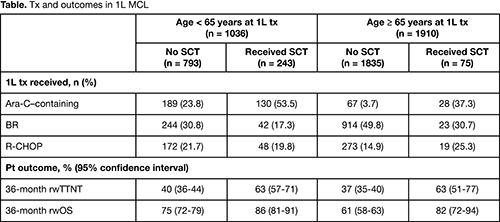
Contributions
Abstract: EP798
Type: E-Poster Presentation
Session title: Indolent and mantle-cell non-Hodgkin lymphoma - Clinical
Background
Mantle cell lymphoma (MCL) is a non-Hodgkin’s lymphoma with heterogeneous biology and outcomes.
Aims
We characterized real-world (RW) treatment (tx) patterns and outcomes of patients (pts) with MCL to identify factors associated with outcomes in the US.
Methods
This retrospective study included adult pts with MCL diagnosed between January 2011 and November 2020 in the nationwide Flatiron Health EHR-derived deidentified database (“MCL-eligible”). Pt characteristics, tx patterns, RW time-to-next tx (rwTTNT, defined as start of first-line [1L] tx to subsequent tx or death), and RW overall survival (rwOS) were evaluated.
Results
3455 pts were included, 85.3% from a community oncology setting. In 2946 (85.2%) pts with documented 1L MCL tx, median age was 69.5 years (range, 27.7-85.3); 9.5% had blastoid/pleomorphic MCL. 262 (39.6%) and 235 (35.6%) of 661 pts with available MCL international prognostic index had intermediate and high risk, respectively. 150/1253 pts (12.0%) with available Eastern Cooperative Oncology Group performance status (ECOG PS) had an ECOG PS ≥ 2. Chemoimmunotherapy was the most common 1L tx, including bendamustine plus rituximab (BR) in 1223 (41.5%), rituximab plus cyclophosphamide, doxorubicin, vincristine, and prednisone (R-CHOP) in 512 (17.4%), and cytarabine (ara-C)-containing tx in 414 (14.1%). 667 pts received R maintenance (MR). In 1036 pts < 65 years, 243 pts received 1L stem cell transplant (SCT), mainly autologous. In 1L-treated pts, with a median follow-up of survivors of 45.3 months (range, 0.03-117.2), median rwTTNT was 24 months; 36-month rwOS was 67%. The Table shows tx received and outcomes by age and SCT status. Multivariate analyses showed age ≥ 65 years, ECOG PS ≥ 2, lactate dehydrogenase/upper limit of normal ≥ 1, white blood cell count ≥ 10 × 109/L, bulky disease (≥ 5 cm), and blastoid/pleomorphic morphology were associated with shorter rwTTNT and rwOS; MR was independently associated with longer rwTTNT and rwOS. In pts < 65 years who were alive and did not initiate subsequent tx within 6 months of 1L tx (“SCT-eligible”), 36-month rwTTNT and rwOS were similar between pts treated with versus without SCT: 65% versus 59% and 86% versus 85%, respectively.

Conclusion
In this large RW cohort of primarily community-based US practices, median 1L rwTTNT for pts with MCL was ~ 2 years. BR was the most commonly used 1L tx. SCT was uncommon even in pts < 65 years, suggesting RW considerations may influence SCT eligibility and availability. Additionally, SCT was not clearly associated with rwOS. As with other reports, older age and high-risk disease features were predictive of worse outcome in RW, while MR appeared to be associated with better outcomes. Outcomes across the board appear worse than prospective trials, suggesting a need to focus on developing tx that can be delivered effectively in the community setting.
Keyword(s): Mantle cell lymphoma, Naive, Non-Hodgkin's lymphoma, Outcome
Abstract: EP798
Type: E-Poster Presentation
Session title: Indolent and mantle-cell non-Hodgkin lymphoma - Clinical
Background
Mantle cell lymphoma (MCL) is a non-Hodgkin’s lymphoma with heterogeneous biology and outcomes.
Aims
We characterized real-world (RW) treatment (tx) patterns and outcomes of patients (pts) with MCL to identify factors associated with outcomes in the US.
Methods
This retrospective study included adult pts with MCL diagnosed between January 2011 and November 2020 in the nationwide Flatiron Health EHR-derived deidentified database (“MCL-eligible”). Pt characteristics, tx patterns, RW time-to-next tx (rwTTNT, defined as start of first-line [1L] tx to subsequent tx or death), and RW overall survival (rwOS) were evaluated.
Results
3455 pts were included, 85.3% from a community oncology setting. In 2946 (85.2%) pts with documented 1L MCL tx, median age was 69.5 years (range, 27.7-85.3); 9.5% had blastoid/pleomorphic MCL. 262 (39.6%) and 235 (35.6%) of 661 pts with available MCL international prognostic index had intermediate and high risk, respectively. 150/1253 pts (12.0%) with available Eastern Cooperative Oncology Group performance status (ECOG PS) had an ECOG PS ≥ 2. Chemoimmunotherapy was the most common 1L tx, including bendamustine plus rituximab (BR) in 1223 (41.5%), rituximab plus cyclophosphamide, doxorubicin, vincristine, and prednisone (R-CHOP) in 512 (17.4%), and cytarabine (ara-C)-containing tx in 414 (14.1%). 667 pts received R maintenance (MR). In 1036 pts < 65 years, 243 pts received 1L stem cell transplant (SCT), mainly autologous. In 1L-treated pts, with a median follow-up of survivors of 45.3 months (range, 0.03-117.2), median rwTTNT was 24 months; 36-month rwOS was 67%. The Table shows tx received and outcomes by age and SCT status. Multivariate analyses showed age ≥ 65 years, ECOG PS ≥ 2, lactate dehydrogenase/upper limit of normal ≥ 1, white blood cell count ≥ 10 × 109/L, bulky disease (≥ 5 cm), and blastoid/pleomorphic morphology were associated with shorter rwTTNT and rwOS; MR was independently associated with longer rwTTNT and rwOS. In pts < 65 years who were alive and did not initiate subsequent tx within 6 months of 1L tx (“SCT-eligible”), 36-month rwTTNT and rwOS were similar between pts treated with versus without SCT: 65% versus 59% and 86% versus 85%, respectively.

Conclusion
In this large RW cohort of primarily community-based US practices, median 1L rwTTNT for pts with MCL was ~ 2 years. BR was the most commonly used 1L tx. SCT was uncommon even in pts < 65 years, suggesting RW considerations may influence SCT eligibility and availability. Additionally, SCT was not clearly associated with rwOS. As with other reports, older age and high-risk disease features were predictive of worse outcome in RW, while MR appeared to be associated with better outcomes. Outcomes across the board appear worse than prospective trials, suggesting a need to focus on developing tx that can be delivered effectively in the community setting.
Keyword(s): Mantle cell lymphoma, Naive, Non-Hodgkin's lymphoma, Outcome


